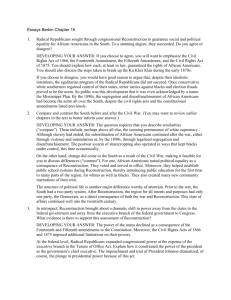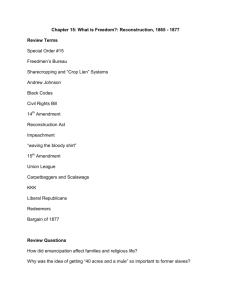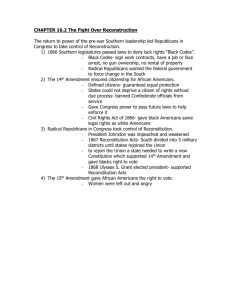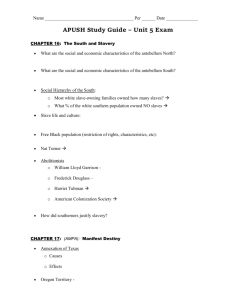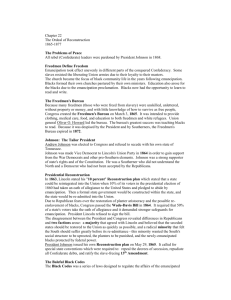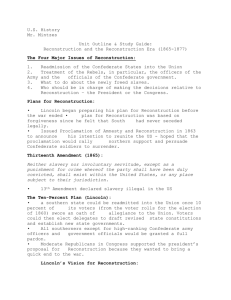1 Reconstruction was the attempt to rebuild and reform the South
advertisement
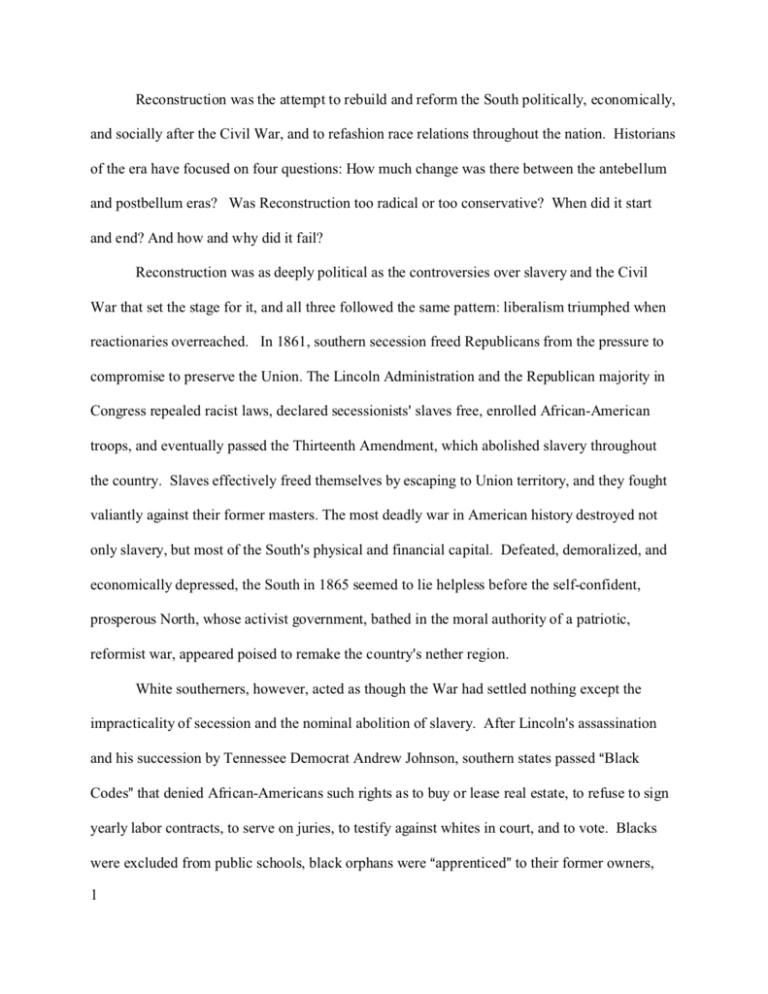
Reconstruction was the attempt to rebuild and reform the South politically, economically, and socially after the Civil War, and to refashion race relations throughout the nation. Historians of the era have focused on four questions: How much change was there between the antebellum and postbellum eras? Was Reconstruction too radical or too conservative? When did it start and end? And how and why did it fail? Reconstruction was as deeply political as the controversies over slavery and the Civil War that set the stage for it, and all three followed the same pattern: liberalism triumphed when reactionaries overreached. In 1861, southern secession freed Republicans from the pressure to compromise to preserve the Union. The Lincoln Administration and the Republican majority in Congress repealed racist laws, declared secessionists= slaves free, enrolled African-American troops, and eventually passed the Thirteenth Amendment, which abolished slavery throughout the country. Slaves effectively freed themselves by escaping to Union territory, and they fought valiantly against their former masters. The most deadly war in American history destroyed not only slavery, but most of the South=s physical and financial capital. Defeated, demoralized, and economically depressed, the South in 1865 seemed to lie helpless before the self-confident, prosperous North, whose activist government, bathed in the moral authority of a patriotic, reformist war, appeared poised to remake the country=s nether region. White southerners, however, acted as though the War had settled nothing except the impracticality of secession and the nominal abolition of slavery. After Lincoln=s assassination and his succession by Tennessee Democrat Andrew Johnson, southern states passed ABlack Codes@ that denied African-Americans such rights as to buy or lease real estate, to refuse to sign yearly labor contracts, to serve on juries, to testify against whites in court, and to vote. Blacks were excluded from public schools, black orphans were Aapprenticed@ to their former owners, 1 and black Aservants@ were required to labor from sunup to sundown for their Amasters.@ White southerners also demanded that a delegation of former Confederate officers and politicians be immediately seated in Congress. But the Republicans who controlled Congress refused to admit the erstwhile rebels, and they took decisive control of Reconstruction. When Johnson vetoed a bill extending the Freedmen=s Bureau, which provided food to destitute southerners of both races, supervised labor contracts, and started schools where ex-slaves could be educated and courts where their concerns could be adjudicated, Republicans in Congress overrode his action, as they did his veto of a Civil Rights Bill that outlawed the Black Codes and mandated basic legal equality. Over unanimous Democratic opposition, Republicans passed the Fourteenth Amendment, which constitutionalized civil rights, seeking to guarantee due process and equality before the law for all. In the critical 1866 election campaign, Johnson demagogically lambasted Congress, northern Democrats endlessly race-baited, and white southerners rioted in Memphis and New Orleans, killing 89 African-Americans, in the full view of the national press. Northern voters reacted by giving the Republicans a landslide, which turned Reconstruction more radical. Ten southern states were placed under temporary military rule, forced to enfranchise AfricanAmerican men and to rewrite their constitutions, and readmitted to Congress only after ratifying the Fourteenth Amendment and much more liberal state constitutions. Because Johnson persisted in trying to subvert the anti-racist settlement, he was impeached, almost convicted, and practically rendered innocuous. Although buttressed by the presence of federal troops, by the Fifteenth Amendment, mandated racially impartial suffrage nationally, and by federal government jobs with which to 2 reward supporters, the new southern governments faced three obstacles that ultimately proved insuperable. First, they had to rebuild the southern infrastructure and satisfy a greatly increased demand for government services, especially education, by raising taxes in a devastated region and after 1873, in a severe economic depression. Second, they had to overcome racism ingrained for two centuries and convince one in four white men to vote for the party that had just defeated their section in a bloody war. Third, they had to repeatedly conquer a foe willing to use any amount of fraud and violence to win elections and delighted to employ ingenious election laws and discriminatory practices to retain power, once they gained it. After northern voters reacted to the depression and northern ethno-religious conflicts by electing a Democratic majority in the House in 1874, it was difficult to see how Reconstruction could survive. Although Republicans rebounded to win the closest presidential election in U.S. history in 1876, part of the price for settling disputes over the election outcome was the implicit promise to stop using the army to protect southern Republicans. The ACompromise of 1877,@ as the settlement became known, marked what is usually treated as the end of Reconstruction. Many historians believe that Reconstruction brought profound changes. As slaves, African-Americans worked very intensively, often in large groups or Agangs,@ under the constant threat of physical punishment. They could not legally marry or learn to read or write. They could be sold or moved against their wills and their families, broken up. Masters constantly intervened in their lives. After emancipation, blacks first worked in Asquads,@ usually headed by independent black contractors, and gradually convinced landowners to let them reside on small family plots, where they enjoyed a degree of privacy and independence. Through sharecropping arrangements, in which workers were paid a percentage of the value of crops after sale, landowners and workers shared the risk of crop failure and guarded against contract violations 3 by either party. Freedmen often used their new right to move to bargain with employers. By 1900, 20 percent of black farm operators owned the land they worked. The U.S. was the only large slave society that quickly enfranchised ex-slaves, and the eagerness and skill with which they took to politics surprised and dismayed their former masters, who had expected docility and incompetence. Almost unanimously supporting the Republican party, the party of abolition and enfranchisement, the freedmen elected governments that launched statewide education systems, encouraged railroads, passed civil rights laws, and protected the rights of laborers. Even after 1877, most black males retained the vote until suffrage restrictions adopted by Democratic legislatures and constitutional conventions in the years around 1900 disfranchised the vast majority of African-Americans and many poor whites. Social changes were also striking. Blacks could legally marry, worship as they wished, form private clubs, receive (inferior) educations at public expense, and often enjoy public accommodations such as restaurants, theaters, and railroads on a non-segregated basis, if they could afford to pay. Absolute segregation of public places arrived only towards the turn of the century, and it was a matter of law, not custom. Historians who stress continuity between the antebellum and postbellum periods point to the sustained, often increased poverty of southern African-Americans; the continuation of the plantation; the survival of many former plantation owners or their sons among the economic and social elite; the eventual disfranchisement and segregation of blacks; and the frequent outbreaks of racist violence, particularly the surge of lynching in the 1890s, which was horrifying enough, though far below Reconstruction levels. The change or continuity question turns on which comparisons one makes: One side emphasizes that blacks were far from slaves; the other, that 4 they were far from first-class citizens. One side, the extent of freedom; the other, the degree of constraint. Historians who believe Reconstruction was too radical contend that more gradual enfranchisement, a stronger Republican alliance with former southern Whigs, and less vigorous attacks on segregation and discrimination would have led to more lasting change. Those who believe it was too conservative say that only widespread land redistribution from former masters to former slaves, and perhaps even the extermination of the planter class, would have brought the social revolution they desire. Critics of the conservative position insist that in the short period when significant change was possible, Radicals had to push for as much reform as they could get, and that the former Whigs, who were largely responsible for the 1865-66 Black Codes, were hardly attractive allies for a party of blacks and poor whites. Critics of the radical position argue that upending the southern order might have frightened northern voters into ending Republican dominance earlier; that it would have hazarded a holocaust of revenge violence; and that in any case, small, undercapitalized farms, most on marginal land, might only have shackled the freedmen and the South to even more poverty. If Reconstruction is held to have ended in 1877, then violence, ballot-box stuffing, and the repudiation of the Republicans for mostly economic reasons play large roles in explanations for its failure. If it is thought to have collapsed a generation later, with the imposition of strict segregation and disfranchisement in the South, then a succession of incremental legal changes and their validation by the Supreme Court account better for its demise. The upsurge of civil rights laws in the North in the 1870s and 80s and the near-passage of the Lodge Elections Bill in 1890 support proponents of a longer Reconstruction and suggest that diffuse northern racism did not account for its waning. In Congress in the nineteenth century, almost all Republicans, but 5 not a single Democrat, supported civil rights measures. Reconstruction was born, lived, and died in political struggle. For Further Reading Dan T. Carter, When the War Was Over (1985) Eric Foner, Reconstruction (1988) William Gillette, Retreat from Reconstruction (1979) Thomas Holt, Black over White (1977) Gerald David Jaynes, Branches Without Roots (1986) J. Morgan Kousser, The Shaping of Southern Politics (1974) Michael Perman, The Road to Redemption (1984) Michael Wayne, The Reshaping of Plantation Society (1983) C. Vann Woodward, The Strange Career of Jim Crow (1974) 6
